 I’m delighted to welcome M.K. (Mary) Tod to my blog again to talk about the inspiration and some background research for her fifth novel, The Admiral’s Wife. In addition to writing fiction, Mary runs the award-winning blog A Writer of History. She can be contacted on Facebook, Twitter and Goodreads or on her website www.mktod.com. You can find all Mary’s books on her Amazon page.
I’m delighted to welcome M.K. (Mary) Tod to my blog again to talk about the inspiration and some background research for her fifth novel, The Admiral’s Wife. In addition to writing fiction, Mary runs the award-winning blog A Writer of History. She can be contacted on Facebook, Twitter and Goodreads or on her website www.mktod.com. You can find all Mary’s books on her Amazon page.
Mary’s previous novels, Unravelled, Lies Told in Silence, and Time & Regret feature characters caught up in the turmoil of the world wars (you can read her post on writing Time & Regret here.) With Paris in Ruins, she goes back to an earlier conflict – the siege of Paris in the 1870s (you can read her post on this period here.)
Now make yourself a nice cuppa and enjoy learning about tea ceremonies and teapots in China!
The Chinese Passion for Tea by MK Tod
Many thanks, Elisabeth. It’s a delight to share some of the inspiration behind The Admiral’s Wife.
Tea. Many of us think of tea as a drink that comes from little bags dipped in hot water. With fancy tea, those little bags might be made of muslin; for ‘regular’ tea like Twinings or Lipton, the bags are made from fine paper.
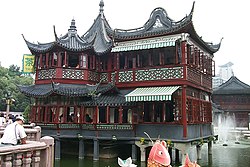 When I moved to Hong Kong, I soon understood that tea was an entirely different experience – a serious pursuit, a ritual, a search for the perfect blend. I remember participating in a formal tea ceremony while visiting Shanghai, a multi-step process that originated over a thousand years ago. I also remember attending a lengthy lecture that covered the history of tea making, the cultivation of tea, the importance of tea to trade between China and other parts of the world, and a discussion of the different types of tea, including white tea. This event ended with a chance to sample several varieties and taste their subtle and not-so-subtle differences.
When I moved to Hong Kong, I soon understood that tea was an entirely different experience – a serious pursuit, a ritual, a search for the perfect blend. I remember participating in a formal tea ceremony while visiting Shanghai, a multi-step process that originated over a thousand years ago. I also remember attending a lengthy lecture that covered the history of tea making, the cultivation of tea, the importance of tea to trade between China and other parts of the world, and a discussion of the different types of tea, including white tea. This event ended with a chance to sample several varieties and taste their subtle and not-so-subtle differences.
In Chinese culture, tea is offered as a sign of respect, to apologize, to show gratitude, and to celebrate weddings. Hong Kong shops display all manner of tea making tools along with a wide range of teapots and cups. These are not the teapots you likely have in your kitchen, but smaller pots, some quite plain and others highly decorative.
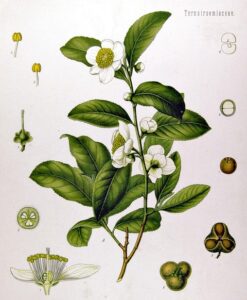
As I wrote The Admiral’s Wife, I wanted to incorporate a tea ceremony. But what would be the circumstances? The story has two main characters: Patricia Findlay, a woman born in America whose parents are Hong Kong Chinese, and Isabel Taylor, a British woman who moves to Hong Kong in 1912 with her husband and young daughter. Isabel is the admiral’s wife.
Patricia has a difficult mother. Wen Wang Shu is domineering and demanding. I decided that Wang Shu would be a tea afficionado and would conduct a tea ceremony to remind her daughter of her Chinese heritage.
Here’s a brief excerpt:
At five minutes to three, the housemaid opened the door of her parents’ grand home. The building filled the contours of the hillside, balconies cantilevered here and there to take advantage of the view. At the eastern end, an annex connected to the main house by a footbridge that crossed a large pond dotted with water lilies. After leaving her shawl and handbag in the front hall—a space that echoed with the sound of water trickling from a marble fountain—Patricia ventured into the living room, where red, black, and gold dominated the color scheme, and plush rugs and antique silk scrolls added to the feeling of luxury. The living room was large enough for two conversation areas; Patricia chose the one centered on a black lacquer coffee table inlaid with mother-of-pearl in the shape of a large crane. In the Chinese culture, the crane symbolized happiness and eternal youth, its powerful wings able to convey souls up to paradise and carry people to higher levels of spiritual enlightenment.
Every element of the house was laid out according to feng shui principles. Though Patricia was in the U.S. during its construction ten years earlier, she knew that the feng shui master had consulted daily with her mother and had blessed the home before anyone set foot in it. Each room had a water feature to facilitate harmony. Doors had been carefully positioned so that good fortune would not inadvertently slip out of the house. In the bedrooms, mirrors were hung away from the foot of the bed to prevent marriage problems.
In the second conversation area, Wang Shu kept an opium bed as a reminder of her grandfather’s addiction and subsequent disgrace. Fortunately, most of his wealth had survived, and his eldest son—Wang Shu’s father—had ultimately doubled the family fortune. Patricia never sat there.
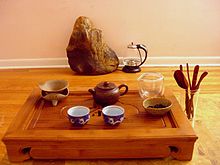 At precisely three o’clock her mother arrived. She had aged considerably in the last five years. Now seventy-four, her black hair was dyed to hide the gray and her cheeks and forehead were unnaturally tight from the latest facelift. As a result of arthritis that had invaded her mother’s left hip and knee, she walked with a slight limp. The slender figure that had once been a source of great pride had given way to a thickened waist and plump arms.
At precisely three o’clock her mother arrived. She had aged considerably in the last five years. Now seventy-four, her black hair was dyed to hide the gray and her cheeks and forehead were unnaturally tight from the latest facelift. As a result of arthritis that had invaded her mother’s left hip and knee, she walked with a slight limp. The slender figure that had once been a source of great pride had given way to a thickened waist and plump arms.
Patricia dutifully kissed her mother’s cheek.
“Tea?” Wang Shu asked.
Patricia nodded. Her mother rang a silver bell, and the housemaid, An Su, appeared almost immediately with a tea tray.
Without wasting any time, Wang Shu began a traditional tea ceremony, which involved two teapots and many steps to ensure that the tea was served at the perfect temperature and taste. The sequence never varied. Patricia had been taught the intricacies of this ceremony when she was ten and knew that her mother was using it to signal filial duty and obedience.
Patricia took a sip and waited for her mother to speak. This too was part of their ritual.
“You’ve been well,” her mother said.
“Yes, very well.”
“Dr. Leung says you haven’t been to see him recently.”
Patricia blew gently on the surface of her tea. “No, not recently. I feel much better, so I’m not taking his pills anymore.”
Doctor Leung had prescribed anti-depressants to combat the fatigue and lethargy that had plagued Patricia after moving to Hong Kong. However, she had no intention of seeing her mother’s physician again. His views of medicine and women were too steeped in Chinese traditions.
“I see. And the Matilda Foundation?” Her mother continued to probe.
“There’s a board meeting next week. I’m looking forward to it. The hospital needs to expand, which will require much planning and significant fundraising. I also spoke to Arthur Chung about job opportunities. He’s very well connected. He said he’s heard about a job that might be suitable and promised to get back to me.”
Wang Shu’s lips turned down. “Your father won’t approve.”
Patricia took another sip of tea and considered how to respond. “Perhaps,” she said eventually, “but whether I work or not is my decision, not his. How is Auntie Ling?”
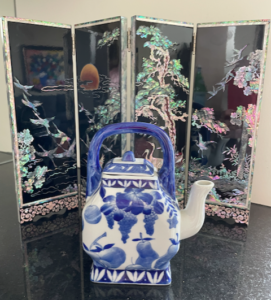 A thin smile emerged on Wang Shu’s face. She nodded a few times, and Patricia wondered if she was debating whether to criticize or ignore her daughter’s forceful declaration.
A thin smile emerged on Wang Shu’s face. She nodded a few times, and Patricia wondered if she was debating whether to criticize or ignore her daughter’s forceful declaration.
“Auntie Ling is very well,” her mother said. “Mei Lan has begun dating a man who is a surgeon. Unfortunately, your brother did not capture her attention. She’s an insipid little thing. Not good enough for my son.”
In an early draft, I described Wang Shu conducting each step of the tea ceremony, but eventually that went into the waste bin. However, you can find a description of the tea ceremony steps here https://www.travelchinaguide.com/chinese-tea-ceremony.htm .
One day, while hiking in the hills surrounding Hong Kong, my friend Rita and I came across a small village where a woman was selling pottery. I bought the little tea pot shown in this photo to remind me of that walk and to take me back to that amazing time and place.
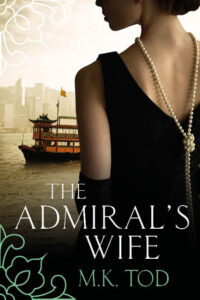
The lives of two women living in Hong Kong more than a century apart are unexpectedly linked by forbidden love and financial scandal.
In 2016, Patricia Findlay leaves a high-powered career to move to Hong Kong, where she hopes to rekindle the bonds of family and embrace the city of her ancestors. Instead, she is overwhelmed by feelings of displacement and depression. To make matters worse, her father, CEO of the family bank, insists that Patricia’s duty is to produce an heir, even though she has suffered three miscarriages.
In 1912, when Isabel Taylor moves to Hong Kong with her husband, Henry, and their young daughter, she struggles to find her place in such a different world and to meet the demands of being the admiral’s wife. At a reception hosted by the governor of Hong Kong, she meets Li Tao-Kai, an influential member of the Chinese community and a man she met a decade earlier when he was a student at Cambridge.
As the story unfolds, each woman must consider where her loyalties lie and what she is prepared to risk for love.
“Family secrets and personal ambitions, east and west, collide in this compelling, deeply moving novel.” — Weina Dai Randel, award-winning author ofTHE LAST ROSE OF SHANGHAI
“Irresistible and absorbing.” Janie Chang, bestselling author of THE LIBRARY OF LEGENDS
“A riveting tale of clashing cultures, ruthless corruption, and the consequences of corrosive lies.” James R Benn, author of ROAD OF BONES and other Billy Boyle mysteries
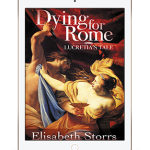 Haven’t subscribed yet to enter into giveaways from my guests? You’re not too late for the chance to win this month’s book if you subscribe to my Inspiration newsletter for giveaways and insights into history – both trivia and the serious stuff! In appreciation for subscribing, I’m offering an 80 page free short story Dying for Rome -Lucretia’s Tale.
Haven’t subscribed yet to enter into giveaways from my guests? You’re not too late for the chance to win this month’s book if you subscribe to my Inspiration newsletter for giveaways and insights into history – both trivia and the serious stuff! In appreciation for subscribing, I’m offering an 80 page free short story Dying for Rome -Lucretia’s Tale.



The Admiral’s Wife sounds just my cup of tea!
I love tea, and the way that scene reflects tensions between ways of seeing the world is so well portrayed.
I must add this to the list of books to read.
This book sounds fabulous! Just added it to my TBR list :)
Love historical fiction that takes place in Asia.
The Admiral’s Wife sounds positively fascinating! I understand well the clash of cultures, my sister-in-law is from Korea. We have talked often about the differences both good and bad in the different time periods. I’m adding this to my TBR list now and sending her the link. Thanks so much Elizabeth 🥰Thanks so much Elizabeth for always hosting the most wonderful authors and their books.
Hi Mia – I so glad you enjoy the newsletter and my featured authors. I love sharing their inspiration with you.
Tea is one of my favorite beverages, so this sounds like my kind of book. It sounds very interesting and I’m always excited to read a book by a new author and share with my book club.
This sounds like my cup of tea. Pun intended 😊